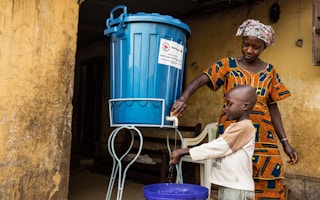Looking back on 2016, there may not seem to be much to celebrate. In terms of global health alone, the year appeared to be one of unrelenting tragedy. Beyond stories of hospitals in conflict zones being bombed, the Zika virus emerged as a growing threat.
To continue reading, subscribe to Eco‑Business.
There's something for everyone. We offer a range of subscription plans.
- Access our stories and receive our Insights Weekly newsletter with the free EB Member plan.
- Unlock unlimited access to our content and archive with EB Circle.
- Publish your content with EB Premium.
There was also the proliferation of antibiotic-resistant microbes, or “superbugs,” the continued revival of yellow fever, and the reemergence of polio in Nigeria, which had previously been declared polio-free. Hopes for a respiratory syncytial virus vaccine were dashed. And in Europe, the incidence of alcohol-related deaths increased.
But, buried among all of the bad stories, there were some inspiring developments in global health in 2016.
The first took place in Tanzania and Mozambique, where African giant pouched rats, which had previously been trained by the Belgian NGO APOPO to detect landmines, were repurposed to help in the fight against tuberculosis (TB).
The rats undergo a thorough training process, in which they are introduced to various stimuli, shown how to interact with people, and taught to detect TB in samples of sputum (mucus that is coughed up from the lower airways). The rats can detect TB with almost 100 per cent accuracy, though they cannot distinguish between normal and drug-resistant strains.
A second positive development was the creation of the Coalition for Epidemic Preparedness Innovations (CEPI). The emergence of infectious diseases (like Ebola, chikungunya, Zika, and, previously, SARS, swine flu, and MERS) typically highlights the inadequate capacity of public-health systems to build up defenses quickly.
CEPI aims to change this. Its members – which come from international organizations, governments, industry, public and philanthropic R&D funders, academia, NGOs, and civil-society groups – will work to develop new vaccines that can prevent emerging infectious diseases from becoming epidemics.
The third positive development of 2016 was the progress made in combating malaria. Deaths from malaria have been on the decline for years. In Africa, which faces the world’s highest malaria mortality rates, the number of victims dropped from more than 800,000 per year in 2000 to roughly 400,000 last year.
Moreover, European drug regulators approved the first licensed human vaccine against malaria – RTS,S, or Mosquirix – in 2015, after nearly three decades of research and development. It will not necessarily be smooth sailing from here: researchers have noticed that the vaccine’s effect weakens over time, and it is only 4 per cent effective over a seven-year period.
But the vaccine remains a major breakthrough. Reflecting its lifesaving potential, the World Health Organization has secured funding for an initial trial phase; beginning in 2018, the WHO will roll out RTS,S in pilot programs that would test its real-world efficacy in Sub-Saharan Africa.
There is more good news on the vaccine front: a herpes vaccine for shingles has been developed. Shingles, a viral disease characterized by a painful skin rash with blisters, is caused by the reactivation of the chickenpox virus within a person’s body.
If the rash involves the eye, vision loss may occur. Some people develop ongoing nerve pain, which can last for months or even years. The new vaccine is significantly more effective than the one that is currently available, which reduces the risk of contracting shingles by only about 50 per cent.
“
However bad things may seem and however heartbreaking the hurdles are, there are plenty of reasons to remain hopeful – and to keep working for a better, healthier future.
Dengue fever, too, is now vaccine-preventable. Dengue, ranked by the World Health Organization (WHO) as the world’s most significant and fastest-growing mosquito-borne viral disease, causes nearly 50 million infections every year. But, in 2016, the first – and, currently, the only – dengue vaccine, Dengvaxia, was approved in 12 countries.
Dengvaxia has received endorsements from key medical societies, at the national and regional levels. The recommendations are consistent with the WHO’s position paper recommending that countries with a high burden of disease consider the introduction of the vaccine as part of an integrated dengue-management program.
As if that were not enough, we now have an Ebola vaccine, too. An experimental vaccine tested on humans has been shown to provide 100 per cent protection against the disease. Though no regulatory authority has approved it yet, it is viewed as so powerful that an emergency stockpile of 300,000 doses has been created for use in the event of another outbreak.
Diseases for which we do not have vaccines have also been beaten back. For example, HIV infections and deaths have stabilized, despite rapid population growth in Africa. This is a testament to the tremendous effort that has been made to fight the HIV/AIDS epidemic, through prevention, education, and treatment programs. To maintain progress against the epidemic, the global health community must sustain these efforts.
Furthermore, the Americas are now almost free of river blindness, a parasitic infection spread by black flies that causes itching and, in severe cases, vision loss. Guatemala has been declared free of the disease, meaning that, in the Americas, only one remote area in the Amazon remains affected.
We are also one step closer to eliminating lymphatic filariasis, also known as elephantiasis. Caused by the filarial worm, elephantiasis is a parasitic infection that can cause horrific swelling of the legs and scrotum. This year, Cambodia, the Cook Islands, Niue, and Vanuatu received acknowledgement from the WHO for having eliminated lymphatic filariasis as a public-health problem.
Also on the brink of eradication is guinea worm,a nasty tropical parasite that spreads via contaminated water. According to the Carter Center, one of the organizations leading the effort to eradicate guinea worm, there were around two dozen cases in the first ten months of 2016. Guinea worm is now on a path to becoming the second human disease ever to be eradicated.
As we begin 2017, it is important to recognize the public-health victories that we have achieved. However bad things may seem and however heartbreaking the hurdles are, there are plenty of reasons to remain hopeful – and to keep working for a better, healthier future.
Melvin Sanicas is a regional medical expert at Sanofi Pasteur.
Copyright: Project Syndicate, 2017.
www.project-syndicate.org











